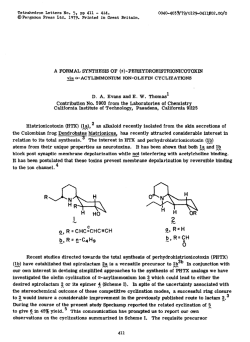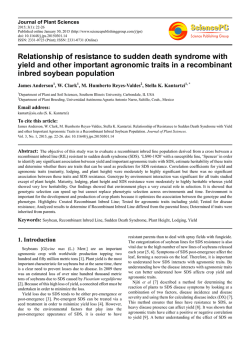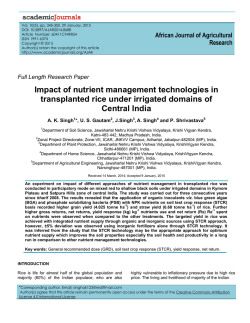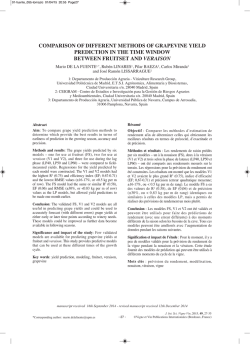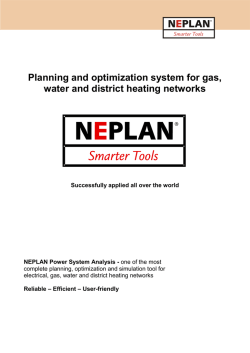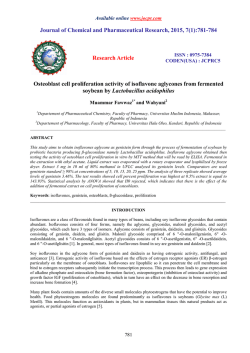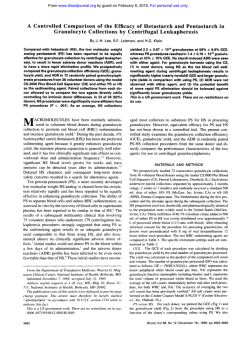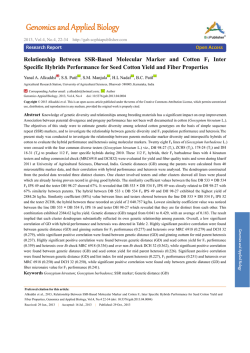
Cultivation of soybean varieties under cross
Vol. 10(5), pp. 404-407, 29 January, 2015 DOI: 10.5897/AJAR2013.7386 Article Number: E286FEF49886 ISSN 1991-637X Copyright © 2015 Author(s) retain the copyright of this article http://www.academicjournals.org/AJAR African Journal of Agricultural Research Full Length Research Paper Cultivation of soybean varieties under cross-seeding system Reginaldo Ferreira Santos1, Doglas Bassegio1*, Bruno Boareto1, Fabíola Tomassoni1, Deonir Secco1, Samuel Nelson Melegari de Souza1 and Tiago Roque Benetoli da Silva2 1 State University of the West of Paraná – Master's Degree in Energy Applied to Agriculture Program, Rua Universitária,. 2069, CEP: 85.819-130, Bairro Faculdade, Cascavel-PR, Brazil. 2 Departamento de Ciências Agronômicas, Campus Avançado de Umuarama, Universidade Estadual de Maringá - Av. Colombo, 5790, 87020-900, Maringá, PR, Brazil. Received 29 May, 2013; Accepted 9 January, 2015 The aim of this study was to evaluate the productivity of four varieties of soybean grown under both cross-seeding and conventional systems. The experiment was conducted in Campina da Lagoa, in the state of Paraná, Brazil during the period from October to February 2012/2013 in a completely randomized factorial scheme (4x2) with five replications. Treatments consisted of four soybean varieties: 4990 Nidera RR, VMAX Syngenta RR, BMX MAGNA RR and 5909 Nidera RR, with two planting systems: crossed and uncrossed. The following components of growth and yield were evaluated: Fresh and dry mass, pod number, plant height and yield in kg-1. Variety VMAX stood out in terms of productivity, regardless of the planting system. The cross-seeding system provided increment of 9.25% in grain yield. Key words: Glycine max, Cross-seeding system, densification. INTRODUCTION Soybean occupies a prominent position in Brazilian agriculture, with 68,688 million tons of grains produced in 23,468 million hectares in crop year 2010/2011 (Conab, 2012). This large increase is due to the productive potential of new genotypes and high technological level of the producer. Cross-seeding is a practice which uses the same technologies already existing for soybean production, but including a variation in the planting scheme. The productive results of cross-seeding have led many researchers to consider that even though the current system of soybean production in Brazil have evolved, there is still room for significant increases in productivity, without interfering in the Amazon, Pantanal, Cerrado, Caatinga or even in the current existing area (Balbinot Junior et al., 2012) New varieties have smaller leaflets, more vertical slope and less branching when compared to traditional cultivars. According to Board (2000), the amount of light reaching the plants through photoreceptors can effectively affect the growth pattern of plants. By considering these two points it is necessary to develop further adjustments in the current system of sowing *Corresponding author. E-mail: [email protected]. Author(s) agree that this article remain permanently open access under the terms of the Creative Commons Attribution License 4.0 International License Santos et al. density and spatial arrangement of these new plant varieties (Souza et al., 2010). The standard population recommended for soybean crops until the 80’s was approximately 400,000 plants ha1 . Bulletin 15 with recommendations for the soybean harvest 2012/13 states that variations between 200 and 500 thousand plants ha-1 do not usually affect grain yield (Embrapa, 2011). Populations above the recommended level lead to expenses with seeds and lodging, besides not providing increases in productivity. Populations below the recommendation favor the development of weed and increase loss at harvest (Vazquez et al., 2008). Balbinot Junior et al. (2012) in studies performed in Londrina - PR, by Embrapa - Brazilian Agricultural Research Corporation, found that grain growth and yield of cultivar BRS 294 RR were not affected by the crossseeding system, and also that the spacing of 0.6 m between rows contributed to higher grain yield when compared to the spacing of 0.4 m. Several works must be conducted to better understand this new planting technique, not only in its aspect of grain production, but also in what concerns to the sustainability of the production system. The aim of this study was to evaluate the growth and grain yield of soybean varieties cultivated under cross-seeding and conventional systems. MATERIALS AND METHODS The experiment was conducted under field conditions on a commercial farm in the agricultural year 2012/2013, during the period from October to February in Campina da Lagoa - PR, Brazil, Latitude: 24° 35' 21" South and Longitude: 52° 49' 34" West, with humid subtropical climate (Köppen-Geiger climate Rating: Cfa) with an average annual rainfall of 1955 mm, annual average evaporation of 1003 mm, average temperature of 21.1°C, 2433 h of insolation per year (IAPAR, 2013) and 561 m (1,841 ft) from the sea. The soil of the experimental area was identified as distroferric Oxisol (Embrapa, 2006). Before the experiment, soil sampling was conducted to determine the chemical and physical characteristics, at the depth of 0-20 cm; results were: 22.48 g dm-3 of organic carbon, pH (CaCl2) 5.10; 6.80 mg dm-3 of P, 0.37 cmolc dm-3 of K+; 4.91 cmolc dm-3 of Ca2+; 1.97 cmolc dm-3 of Mg2+; 5.35 cmolc dm-3 H + Al; CTC 12.60 cmolc dm-3 and 57.54% of base saturation. Physical characteristics at the same depth were: 700 g kg-1 of clay, 200 g kg-1 of silt and 100 g kg-1 of sand fraction. The factorial design (4×2) was completely randomized with five replications. The treatments were formed by the combination of four varieties and two planting systems (crossed and uncrossed). The plots were 7 m long and 3.42 m wide (9 lines of 0.38 m) totaling 23.94 m2. Sowing was held on 04/10/2012 under direct-drilling system under AG9010 corn residues, with soybean varieties: 4990 Nidera RR, VMAX Syngenta RR, BMX MAGNA RR and 5909 Nidera RR, using a seed-fertilizer (Semeato PS8/9L). Basic fertilization consisted of applying 24 kg ha-1 of nitrogen, 180 kg ha-1 of K2O and 60 kg ha-1 of P2O5 with formula 4-30-10 NPK. 657,000 and 497,000 seeds ha-1 were used in cross-seeding and conventional systems, respectively. In coverage, 180 kg ha-1 of potassium chloride were applied 20 days after sowing. The control of pests, diseases and weeds was performed according to the technical indications for the crop. Due to the harvest it was necessary to determine plant height in 405 function of the distance from the ground up to the apical meristem of the main stem of 10 soybean seedlings chosen randomly within each plot. Soybean yield was estimated by collecting existing plants in one square meter in the center of the plot, with values corrected to moisture of 13% and expressed in kg ha-1. The fresh and dry mass of plants were also determined, by cutting the plants at ground level in each plot, which were placed in plastic bags to prevent moisture loss and, soon after, weighed. The material was dried in an oven with forced air circulation at 65°C until it reached constant weight and then weighed in order to determine its dry mass. The results for yield and production components were subjected to analysis of variance and the averages compared by Tukey’s test at 5% probability, using the statistical package Assistat® version 7.5 beta (Silva and Azevedo, 2002). RESULTS AND DISCUSSION The behavior of the analysis of variance is presented in Table 1. Yield components were significantly affected (p ≤ 0.01) in function of varieties and planting systems. There was significant interaction between the factors “variety” and “planting system” for all production components. Due to the interaction between variety and planting system it is necessary to analyze the unfolding (Table 2) for fresh and dry mass, pod number, plant height and yield. The fresh and dry mass was influenced by varieties and planting system, as well as by the interaction between factors. All varieties showed an increase of fresh and dry mass in the cross-seeding planting system. Variety VMAX, which presents an upright set and indeterminate growth habit stood out in the accumulation of fresh and dry mass, with 9.26 and 8.92%, respectively, in the cross-seeding system in comparison to the conventional method. Rodrigues et al. (2007) observed higher production of dry mass for denser spacings for the same population of plants. Balbinot Junior et al. (2012) obtained contradictory results working with crossed soybean spacing system in Paraná; the largest accumulation of dry leaves, branches and pods per plant was in one with 375,000 seeds ha-1 compared to 562,500 seeds ha-1, namely conventional and cross-seeding systems, respectively. According to Bruin and Pedersen (2009) genotypes of modern growing habits have higher grain yield due to higher yield per plant and higher tolerance to high densities, and can be explained by the higher dry mass accumulation in the vegetative stage, which promotes the setting of many vegetables and grains with consequent maintenance of the active drain and photosynthetic activity for more time. Kahlon et al. (2011) point out that modern genotypes have a greater number of reproductive nodes and grains per area due to increased radiation interception. By analyzing the results in the unfolding against the component “number of pods per plant”, one can note that the conventional planting system (no cross) stood out, 406 Afr. J. Agric. Res. Table 1. Aerial fresh matter (FM), aerial dry matter (DM), number of pods/plant (NP), plant height (PH) and yield. Treatments Varieties 4990 Nidera VMAX MAGNA 5909 Nidera Planting system Crossed Uncrossed CV(%) FM (g) DM (g) NP (no) PH (cm) Yield (kg ha-1) 0.93d 1.80a 1.18c 1.28b 0.32d 0.52a 0.38c 0.42b 26.48c 25.97d 28.38b 31.67a 61.90d 79.00b 75.50c 82.40a 2151.4d 4172.2a 2733.3c 2979.4b 1.36a 1.24b 1.54 0.43a 0.39b 3.74 21.35b 34.90a 1.31 76.20a 73.20b 1.27 3144.4a 2873.7b 1.54 ** ** ** ** ** ** ** ** ** ** ** ** ** ** ** Varieties (A) Planting system (B) AxB ** Significant at 1 % of probability. Table 2. Unfolding of the interaction varieties/planting system for aerial fresh matter, aerial dry matter, number of pods/plant, plant height e yield. Varieties Crossed Planting system Uncrossed Aerial fresh matter (g) 4990 Nidera VMAX MAGNA 5909 Nidera 0.9858dA 1.8930aA 1.2166cA bA 1.3470 0.8760dB 1.7176aB 1.1488cB bB 1.2314 Aerial dry matter (g) 4990 Nidera VMAX MAGNA 5909 Nidera 0.3234dA 0.5492aA 0.4136cA 0.4630bA 0.3192dA 0.5000aB 0.3540cB 0.3926bB Number of pods/plant 4990 Nidera VMAX MAGNA 5909 Nidera 21.34bB 14.48cB 21.68bB 27.91aB 31.62cA 37.45aA 35.08bA 35.08bA Plant height (cm) 4990 Nidera VMAX MAGNA 5909 Nidera 70.20cA 60.60dB 82.20bA 91.80aA 53.60dB 97.40aA 68.80cB 73.00bB 2278.29dA 4374.93aA 2811.69cA 3113.06bA 2024.53dB 3969.56aB 2655.00cB 2845.90bB Yield (kg ha-1) 4990 Nidera VMAX MAGNA 5909 Nidera Means with different small letters in the columns are statistically different at (**) 1% and (*) 5% of probability or no significant (n.s.) Tukey test. Santos et al. with variety VMAX getting the highest averages. In the cross-seeding system, variety semi erect 5909 Nidera presented more pods per plant. Chaves (2012) observed a linear decrease in the number of pods per reproductive node with densification of population in the variety Nidera 5909. The reduction of pods per plant when the culture is subjected to densification and increase of population is also reported by Kuss et al. (2008). Plant height was changed depending on the varieties and planting system. One may observe in Table 2 that in the cross-seeding system, variety 5909 Nidera stood out for showing taller plants. The cross-seeding system between rows and plant densification did not result in increased plant height compared to the conventional system, what disagrees with Balbinot Junior et al. (2012) who observed an increase in plant height in the crossseeding system, which according to the author possibly happened due to the lower quality of light. Hicks et al. (1969) point out that the increase in plant height with reduced spacing is more significant in varieties of low stature. Under low light quality soybean plants tend to exhibit high development in height in order to trap these features, besides emitting fewer branches (Board, 2000). The results of this experiment are possibly due to the fact that all varieties in this study present upright growth habit, which means that they are resistant to densification and lodging. As for grain yield, one can observe that variety VMAX stood out in terms of productivity, regardless of the planting system. It is observed (Table 2) that in the conditions of this study there was an increase of 9.25% in grain yield of the variety compared to the conventional system. Balbinot Junior et al. (2012) verified no effect of the cross-seeding system for variety BRS 294 RR with determined growth habit in grain yield. Conflict of Interest The author(s) have not declared any conflict of interest. Conclusion Variety VMAX stood out in terms of productivity, regardless of the planting system. The cross-seeding system provided an increase of 9.25% in grain yield. REFERENCES Balbinot Jr AA, Procópio SO, Franchini JC, Debiasi H, Panison F (2012). Avaliação do sistema de plantio cruzado da soja- cultivar de hábito indeterminado. 6º congresso Brasileiro de Soja pp. 1-4. Board J (2000). Light interception efficiency and light quality affect yield compensation of soybean at low plant population. Crop Sci. 40:12851294. http://dx.doi.org/10.2135/cropsci2000.4051285x 407 Bruin JL de, Pedersen P (2009). New and old soybean genótipo responses to plant density and intercepted light. Crop Sci. 49:22252232. http://dx.doi.org/10.2135/cropsci2009.02.0063 Chaves A (2012). Formação do rendimento de grãos de soja em função de arranjos de plantas, genótipos e épocas de semeadura. Tese de Doutorado em Universidade Universidade de passo fundo P. 227. Conab-Companhia Nacional de Abastecimento (2012). Acompanhamento da safra brasileira de grãos (safra 2011/12) – 8º levantamento, maio, 2012. Disponível em: <http://www.conab.gov.br/OlalaCMS/uploads/arquivos/11_06_09_08 _50_47_graos_-_boletim_maio-2012.pdf>. Acesso em 19/03/2013. Embrapa (2011). Empresa Brasileira de Pesquisa Agropecuária. Tecnologias de produção de soja – região central do Brasil 2012 e 2013. Embrapa Soja, P. 261. Embrapa (2006). Empresa Brasileira de Pesquisa Agropecuária. Serviço Nacional de Levantamento e Conservação de Solos. Sistema brasileiro de classificação de solos. 2nd ed. Rio de Janeiro: Embrapa Solos P. 306. Hicks DR, Pendleton JW, Bernard RL, Johnston TJ (1969). Response of soybean plant types to planting patterns. Agron. J. 61:290-293. http://dx.doi.org/10.2134/agronj1969.00021962006100020034x IAPAR (2013). Instituto Agronômico do Paraná. Médias históricas em estações do IAPAR. Disponívelem: http://www.iapar.br/arquivos/Image/monitoramento/Medias_Historica s/Cascav-el.html Acesso em: 11 mar. 2013. Kahlon CS, Board JE, Kang MS (2011). An analysis of yield component changes for new vs. old soybean Genótipos. Agron. J. 103:1322.http://dx.doi.org/10.2134/agronj2010.0300 Kuss RCR, Könnig O, Dutra LMC, Bellé RA, Roggia S, Sturmer GR (2008). População de plantas e estratégias de manejo de irrigação na cultura da soja. Ciênc. Rural 38:1133-1137. http://dx.doi.org/10.1590/S0103-84782008000400036 Rodrigues O, Teixeira MC, Costenaro ER, Bertagnolli PF (2007). Avaliação de cultivares de soja transgênica (BRS-RR) em sistema precoce de semeadura (SPS). Passo Fundo: Embrapa Trigo, P. 30. Silva FAZ, Azevedo CAV (2002). Versão do programa computacional Assistat para o sistema operacional Windows. Rev. Bras. Prod. Agroind. 4:71-78. Souza CA, Gava F, Casa RT, Bolzan JM, Kuhnem PRJ (2010). Relação entre densidade de plantas e genótipos de soja Roundup Ready TM. Planta Daninha 28:887-896. http://dx.doi.org/10.1590/S010083582010000400022 Vazquez GH, Carvalho NM, Zocoller MB (2008). Redução na população de plantas sobre a produtividade e a qualidade fisiológica da semente de soja. Rev. Bras. Sementes 30:01-11.
© Copyright 2025


